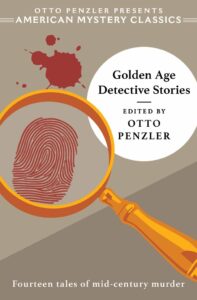One of the favorite sports of mystery critics, historians, and scholars is trying to determine when the mystery genre began, who invented it, and what is the first story or novel in the genre. The other favorite occupation is defining what a mystery is in the first place.
I am not eager to get sucked into the first controversy, in which some have claimed the Bible, specifically Cain slaying Abel, as the first murder story, though there’s not much mystery involved. Others point to Shakespeare, notably Macbeth, but murder and puzzlement turn up in other of his plays as well.
The first memorable act of pure detection is often credited to Voltaire, when his character Zadig makes observations of ordinary facts and then infers events that he could not have seen. Although not specifically involved with crimes, his deductions made him the first systematic detective in literature in 1748.
Embracing the notion of observation and deduction in the solution to criminal mysteries, Edgar Allan Poe can claim with great justification the honor of inventing the detective short story in 1841 when he produced “The Murders in the Rue Morgue.” William Leggett’s “The Rifle” preceded Poe’s tale by fourteen years and is largely a textbook of observation and deduction, but the author was not as gifted a storyteller as the master and his story quickly faded into obscurity. Most writers of introductions to mystery books are quite content to leave the honor of invention to Mr. Poe.
While more and more bits of what is now regarded as the mystery novel were added to gothic fiction, they finally coalesced in Charles Dickens’s Bleak House (1852-1853) to produce a detective, Inspector Bucket, within the confines of a larger novel with greater ambition than producing a detective novel. Wilkie Collins, a close friend to Dickens, soon followed with The Woman in White (1860) and The Moonstone (1868), described by T.S. Eliot as the first, the longest, and the best detective novel ever written.
With the creation of Sherlock Holmes in A Study in Scarlet (1887) and, more significantly, the short stories that followed in 1891 and after, the detective story was in full bloom and has never again lost its position as a successful and much-loved literary form.
The history of mystery fiction does not have definitive moments, chiseled in granite, that define the exact time when it can be inarguably stated that—aha!—that is the moment, or the author, or the story, that changed literature forever.
Defining what is a mystery is just as elusive as pinpointing its invention. I have customarily described “mystery” as any work of fiction in which a crime, or the threat of a crime, is central to the plot or theme of the work. I would not argue against anyone who suggests that this is an extremely expansive view of the genre, as it includes the detective story, crime fiction, psychological suspense, espionage, thriller, noir, police procedural, private eye, and variations and sub-genres of seemingly infinite variety.
It is an imperfect definition, to be sure, as it would necessarily have to include western fiction, which almost invariably includes a crime or crimes but, since it is its own genre (which has its own challenges, both in claiming the date of its creation and in being defined) it can be left aside.
An area where we may come to a little more accuracy and general agreement about its parameters is the Golden Age of detective fiction. Most people glibly define it as books and stories written between the two world wars, and point to the first Agatha Christie novel, The Mysterious Affair at Styles (1920) as the benchmark novel. Of course, nothing is quite so simple, as it was published two years after the Great War ended and the time frame ignores E. C. Bentley’s masterpiece, Trent’s Last Case (1913). At the other end of the time continuum, many of the Golden Age writers who got their start in the 1920s were still going strong after World War II ended in 1945. Two of the genre’s giants, in fact, Christie and Ellery Queen, were still releasing novels in the 1970s, as was John Dickson Carr, whose first book was published in 1930.
The Golden Age may be considered in the same fashion as we refer to art, which is that we know it when we see it. The time frame, and even the specific sub-genre of the detective story as one of the buckets of water in the deep well of mystery fiction, may be elastic enough that they do not fit little pigeon holes of dates and genre, nor should we care.
Which brings us to American Golden Age Detective Stories, which features virtually all the giants of mystery fiction produced between the world wars. Alas, no Charlie Chan, no Philo Vance, no Mr. Moto, as their authors never wrote short stories featuring those detectives.
This delightful cornucopia of crime does feature Ellery Queen, of whom Anthony Boucher once gushed, “is the American detective story” in a New York Times book review, and Boucher, for whom the World Mystery Convention was unofficially named the Bouchercon, is in these pages, too. So is Mary Roberts Rinehart, who, for about a quarter of a century, was one of the two bestselling authors in America. For aficionados of impossible crimes, you will find Clayton Rawson and his magician detective, the Great Merlini. For charming couples rivaled only by Nick and Nora Charles (who appeared only in a single novel, The Thin Man), we offer Peter and Iris Duluth and Mr. and Mrs. North, who got their name from a bridge hand. Masters of suspense are here, too, with Cornell Woolrich, the Poe of the twentieth century, and Charlotte Armstrong, whose work has inspired outstanding films of suspense. If you like humor, there’s a story by Craig Rice, the first mystery writer to grace the cover of Time magazine, and Stuart Palmer’s Hildegarde Withers, she of the weird and wild hats. Baynard Kendrick, who holds card number one from the Mystery Writers of America, which he co-founded, is here with his blind detective, and so is Mignon G. Eberhart, the Mary Higgins Clark of her era. Iconic detectives? How about Mr. Mycroft, who some seem to think is a pseudonym for Sherlock Holmes who only wants privacy as he keeps bees in Sussex, and Perry Mason, Erle Stanley Gardner’s lawyer detective who is the bestselling American mystery writer of all time.
Here, then, for our pleasure and edification, our scrutiny and curiosity, our solace and joy, are some examples of the most illustrious writers of the traditional and classic detective story.
___________________________________
Excerpted from the Introduction to Golden Age Detective Stories, edited by Otto Penzler. Published by American Mystery Classics, Mysterious Press. Reprinted with permission. All rights reserved.


















